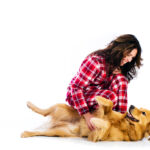Why Does My Female Dog Pee In My Bed
Understanding Why Your Female Dog Pees in Your Bed
If you are a dog owner, especially of a female dog, you may have experienced the frustrating and embarrassing situation of finding your bed soaked with urine. While it may seem like an intentional act of revenge or disobedience, your dog is actually communicating something to you through her behavior. In this article, we will explore some possible reasons why your female dog pees in your bed and what you can do about it.
Possible Reasons for Female Dogs Peeing in Beds
1. Medical Issues: The first thing you should check when your dog starts peeing in unusual places, including your bed, is her health status. Urinary tract infections, bladder stones, hormonal imbalances, and other medical conditions can cause dogs to feel the urge to urinate more frequently or uncontrollably. If your dog shows other signs of discomfort or pain during urination or has a history of urinary problems, take her to the vet as soon as possible.
2. Anxiety and Stress: Dogs, like humans, can suffer from anxiety and stress due to various triggers such as separation from their owners, changes in routine, new environments, loud noises, and other dogs or animals. When dogs feel anxious or stressed, they may resort to destructive behaviors such as chewing, digging, scratching, or peeing in inappropriate places. If your dog only pees on your bed when you are away or after a stressful event has occurred, try to identify and address the root cause of her anxiety.
3. Territorial Marking: Dogs have a strong sense of smell and use their urine to mark their territory and communicate with other dogs. Female dogs may also mark their territory by peeing on beds or other items that smell like their owners or other pets they perceive as threats or rivals. If your dog seems possessive or jealous of your attention or resources, such as food bowls or toys, she may be marking her territory to assert dominance or claim ownership.
4. Inadequate Housetraining: Dogs need to learn where and when it is appropriate to urinate and defecate, and it is the owner’s responsibility to provide consistent and positive training methods. If your dog has not been properly housetrained or has regressed in her training due to inconsistent reinforcement or punishment, she may not understand that peeing on beds is not acceptable behavior. Reinforce positive behaviors with praise, treats, and attention, and avoid punishing or scolding your dog for accidents.
5. Physical Limitations: Some female dogs, especially older ones or those with mobility issues, may find it difficult or painful to go outside or use a designated potty area. If your dog cannot hold her bladder for long periods of time or cannot climb stairs or jump down from furniture easily, she may choose to pee on the closest soft surface available. Consider providing more comfortable bedding for your dog, such as orthopedic foam mattresses or heated pads, and make sure she has easy access to water and food.
What You Can Do About Your Female Dog Peeing in Your Bed
1. Rule out medical issues: Before trying any behavioral modification techniques, make sure your dog is healthy and does not have any underlying medical conditions that require treatment. Follow your vet’s advice regarding medication, diet changes, and monitoring of symptoms.
2. Clean up thoroughly: Urine stains can leave lasting smells and marks on fabrics and surfaces, which can attract your dog back to the same spot. Use enzymatic cleaners specifically designed for pet urine removal to neutralize the odor and break down the proteins that cause staining. Avoid using ammonia-based cleaners or bleach, as they can actually worsen the smell and irritate your dog’s nose.
3. Set boundaries: Make it clear to your dog that peeing on beds is not allowed by using positive reinforcement to reward desired behaviors and redirecting her attention to appropriate activities. Use verbal cues, such as “potty outside” or “go to your bed”, and praise or treat your dog when she follows them correctly. Consider using baby gates or crates to limit your dog’s access to certain areas of the house when you are not available to supervise her.
4. Reduce anxiety and stress: Address any triggers that may be causing your dog to feel anxious or stressed, such as separation anxiety, noise phobia, or socialization issues. Provide plenty of physical exercise, mental stimulation, and affectionate bonding time with your dog. Consider using natural supplements or calming aids, such as pheromone diffusers or herbal remedies, under the guidance of your vet.
5. Seek professional help: If your dog’s peeing behavior persists despite your efforts to address it, consider consulting a certified animal behaviorist or trainer who can assess the situation and recommend personalized solutions. Avoid using punishment-based methods or aversive devices, such as shock collars or spray bottles, which can harm your dog’s trust and bond with you.
Conclusion
Female dogs may pee in beds for various reasons related to their health, behavior, training, and environment. By understanding the possible causes of this behavior and taking appropriate measures to address them, you can help your dog feel more comfortable and confident in her living space and avoid further accidents. Remember to be patient, consistent, and loving with your furry friend, and enjoy the companionship that only dogs can offer.



